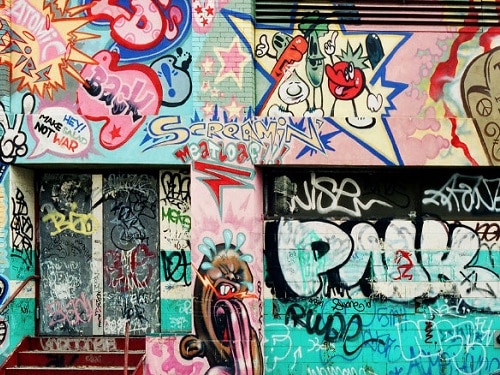Towards the end of the 1960s graffiti found its roots not in New York but in Philadelphia. It wasn’t until the early 1970s, when stylised initials and signatures, known as ‘tags’ began appearing on New York trains, that Street Art became part of the wider public consciousness.
Visual codes established at that time are still in effect forty years later. The street artists known as Blade and Seen (the Godfather of Graffiti) were considered to be the early masters and their knowledge, skills and techniques have been passed on from generation to generation. From simple writing on walls, these artists developed a unique style and set the foundations of a new art form.
The ‘old school’ graffiti of the 1970s and 80s is now easily recognisable. Beyond the chosen surface, whether on the subway, on a wall or canvas, the spray-can techniques are inextricably linked to Street Art. Artists such as A-One, DONDI or Futura have been key in transforming the practice into a movement. As they experimented they fed their passion in every possible way. Emulation and adrenaline played an important role in the energy and uniqueness of their early work.

Crash (b. 1961)
Untitled, 1982
Spray paint on canvas
Lourdel Collection
Photo: courtesy of Stéphane Bisseuil


QUIK (b.1958)
I'll never grow old, 1987
Spray paint on canvas
Lourdel Collection

Futura (b.1955)
Untitled, c. 1982
Spray paint on concert background
Lerouge Collection
Photo: courtesy of Stéphane Bissseuil


A-One (1964–2001)
The Babylon System, the Prophet, 1985 Spray paint on canvas
Private Collection

DONDI (b. 1961)
Untitled, 1984
Spray paint on canvas
Private Collection


Blade (b. 1958)
Distant Traveller, 1987
Spray paint and marker on canvas
Blade was only 15 years old when he formed the Crazy Five Crew. He was later nicknamed the “King of Whole Cars” after having spray painted 5,000 subway cars in total on lines 5 and 2 of the New York subway between 1975 to 1980.
Blade’s contribution to graffiti culture is fundamental as he was the first artist to develop the entire composition around an initial tag. With this approach, the trend was not just about writing one’s name as big as possible but also about the careful choice of colours and the addition of objects and symbols to the composition, as well as the use of perspective and geometry.

